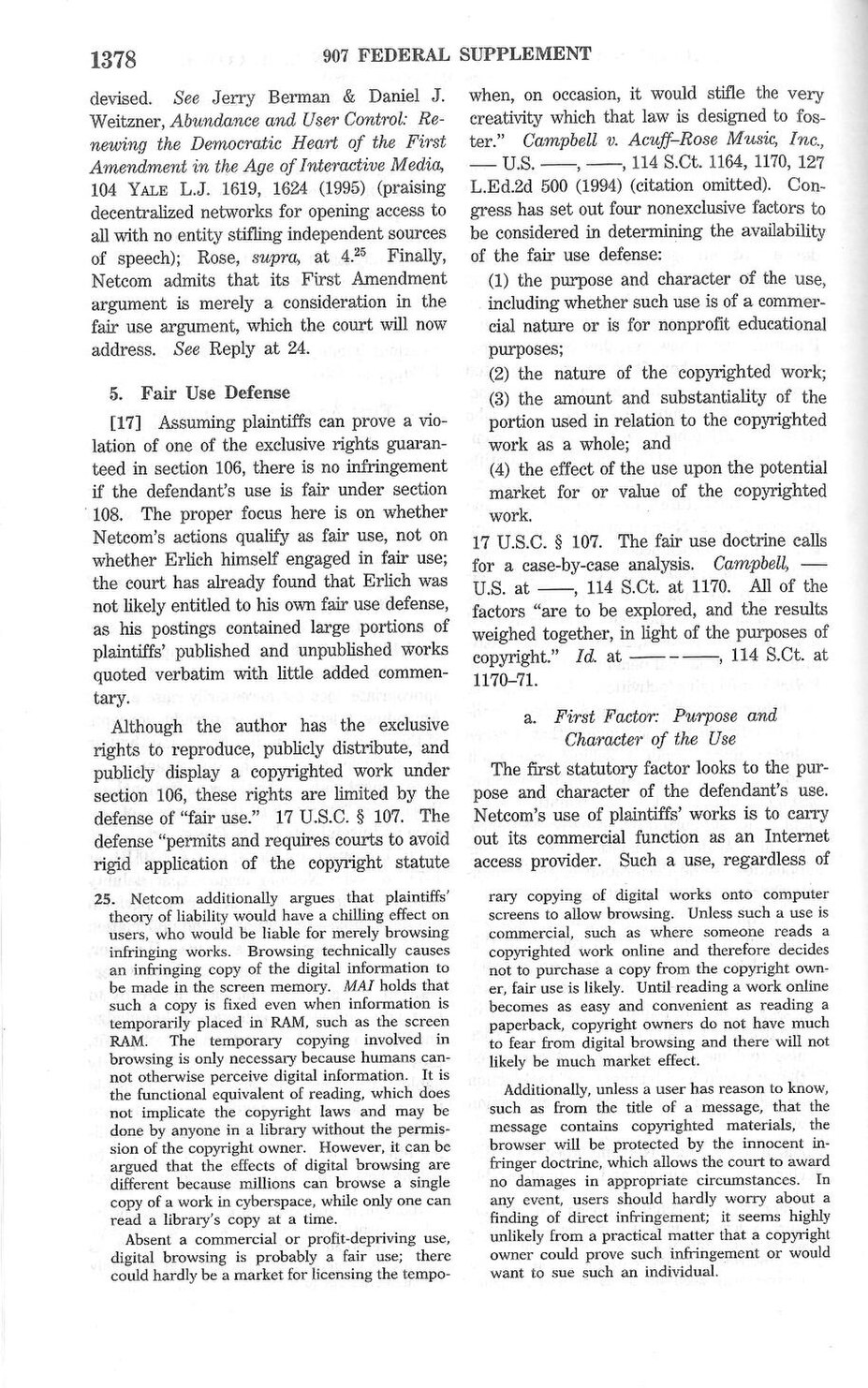devised. See Jerry Berman & Daniel J. Weitzner, Abundance and User Control: Renewing the Democratic Heart of the First Amendment in the Age of Interactive Media, 104 Yale L.J. 1619, 1624 (1995) (praising decentralized networks for opening access to all with no entity stifling independent sources of speech); Rose, supra, at 4.[1] Finally, Netcom admits that its First Amendment argument is merely a consideration in the fair use argument, which the court will now address. See Reply at 24.
- 5. Fair Use Defense
Assuming plaintiffs can prove a violation of one of the exclusive rights guaranteed in section 106, there is no infringement if the defendant’s use is fair under section 108. The proper focus here is on whether Netcom’s actions qualify as fair use, not on whether Erlich himself engaged in fair use; the court has already found that Erlich was not likely entitled to his own fair use defense, as his postings contained large portions of plaintiffs’ published and unpublished works quoted verbatim with little added commentary.
Although the author has the exclusive rights to reproduce, publicly distribute, and publicly display a copyrighted work under section 106, these rights are limited by the defense of “fair use.” 17 U.S.C. § 107. The defense “permits and requires courts to avoid rigid application of the copyright statute when, on occasion, it would stifle the very creativity which that law is designed to foster.” Campbell v. Acuff-Rose Music, Inc., –— U.S. —, —, 114 S.Ct. 1164, 1170, 127 L.Ed.2d 500 (1994) (citation omitted). Congress has set out four nonexclusive factors to be considered in determining the availability of the fair use defense:
(1) the purpose and character of the use, including whether such use is of a commercial nature or is for nonprofit educational purposes;
(2) the nature of the copyrighted work;
(3) the amount and substantiality of the portion used in relation to the copyrighted work as a whole; and
(4) the effect of the use upon the potential market for or value of the copyrighted work.
17 U.S.C. § 107. The fair use doctrine calls for a case-by-case analysis. Campbell, – U.S. at —, 114 S.Ct. at 1170. All of the factors “are to be explored, and the results weighed together, in light of the purposes of copyright.” Id. at — – —, 114 S.Ct. at 1170–71.
a. First Factor: Purpose and Character of the Use
The first statutory factor looks to the purpose and character of the defendant’s use. Netcom’s use of plaintiffs’ works is to carry out its commercial function as an Internet access provider. Such a use, regardless of
- ↑ Netcom additionally argues that plaintiffs’ theory of liability would have a chilling effect on users, who would be liable for merely browsing infringing works. Browsing technically causes an infringing copy of the digital information to be made in the screen memory. MAI holds that such a copy is fixed even when information is temporarily placed in RAM, such as the screen RAM. The temporary copying involved in browsing is only necessary because humans cannot otherwise perceive digital information. It is the functional equivalent of reading, which does not implicate the copyright laws and may be done by anyone in a library without the permission of the copyright owner. However, it can be argued that the effects of digital browsing are different because millions can browse a single copy of a work in cyberspace, while only one can read a library’s copy at a time.
Absent a commercial or profit-depriving use, digital browsing is probably a fair use; there could hardly be a market for licensing the temporary copying of digital works onto computer screens to allow browsing. Unless such a use is commercial, such as where someone reads a copyrighted work online and therefore decides not to purchase a copy from the copyright owner, fair use is likely. Until reading a work online becomes as easy and convenient as reading a paperback, copyright owners do not have much to fear from digital browsing and there will not likely be much market effect.
Additionally, unless a user has reason to know, such as from the title of a message, that the message contains copyrighted materials, the browser will be protected by the innocent infringer doctrine, which allows the court to award no damages in appropriate circumstances. In any event, users should hardly worry about a finding of direct infringement; it seems highly unlikely from a practical matter that a copyright owner could prove such infringement or would want to sue such an individual.
